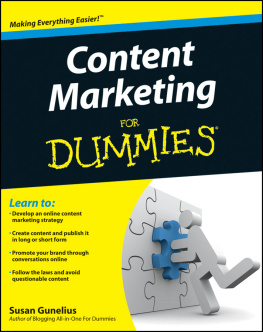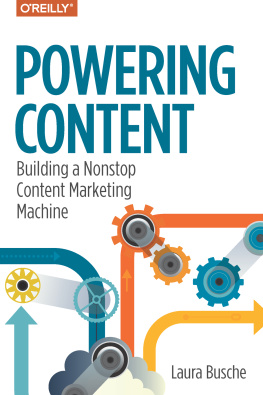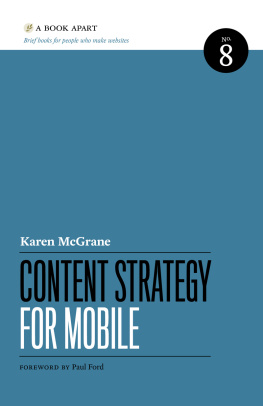Copyright 2019 Torrey Podmajersky. All rights reserved.
Printed in the United States of America.
Published by OReilly Media, Inc., 1005 Gravenstein Highway North, Sebastopol, CA 95472.
OReilly books may be purchased for educational, business, or sales promotional use. Online editions are also available for most titles (http://oreilly.com). For more information, contact our corporate/institutional sales department: (800) 998-9938 or corporate@oreilly.com.
June 2019: First Edition.
See 0636920235583 for release details.
The OReilly logo is a registered trademark of OReilly Media, Inc. Strategic Writing for UX and related trade dress are trademarks of OReilly Media, Inc.
Many of the designations used by manufacturers and sellers to distinguish their products are claimed as trademarks. Where those designations appear in this book, and OReilly Media, Inc., was aware of a trademark claim, the designations have been printed in caps or initial caps.
Although the publisher and author have used reasonable care in preparing this book, the information it contains is distributed as is and without warranties of any kind. This book is not intended as legal or financial advice, and not all of the recommendations may be suitable for your situation. Professional legal and financial advisors should be consulted, as needed. Neither the publisher nor the author shall be liable for any costs, expenses, or damages resulting from use of or reliance on the information contained in this book.
[ Preface ]
UX writing is the process of creating the words in user experiences (UX): the titles, buttons, labels, instructions, descriptions, notifications, warnings, and controls that people see. Its also the setup information, first-run experience, and how-to content that gives people confidence to take the next step.
When an organization depends on individual humans performing specific behaviors like buying tickets for events, playing a game, or riding public transit, words are ubiquitous and effective. Words can be seen on screens, signs, posters, and articles, as well as heard from devices and videos. The text can be minimal, but is very valuable.
But what do those words do, how do we choose them, and how do we know when they work? This book provides strategies to use UX writing to help meet peoples goals while advancing our organizations toward converting, engaging, supporting, and reattracting those people. We structure our voice throughout the content so that the brand is recognizable to its audience. We apply common UX text patterns to ease and democratize the task of writing, and we measure how effective the UX content is.
Who Should Read This Book
If you need to write UX content on top of your usual job, you might be a marketing professional, technical writer, UX designer, product owner, or a software engineer. This book equips you with knowledge about what goals the UX content can accomplish, frameworks for writing it, and methods to measure it.
If you are or will be a UX writer, or if youre a manager or leader who wants to support a UX writer on your team, this book also gives you methods to demonstrate the value of UX writing and the impact it makes. In this book, youll find processes and tools to do the work of writing and the work of partnering with design, business, legal, engineering, product, and other stakeholders sanely, creatively, and scalably.
How This Book Is Organized
Chapter explains why UX content matters and how it integrates with the software development life cycle.
Chapter provides a framework for the voice of the experience to align the UX content with the product principles.
Chapter describes a process of content-first design for UX text, rooted in conversation.
Chapter provides patterns for UX text and demonstrates how they work in the three different voices of the example experiences.
Chapter presents a four-phase process of editing UX text to be purposeful, concise, conversational, and clear.
Chapter outlines three methods to measure the effect and quality of UX content: direct measurement, UX research, and heuristic analysis.
Chapter recommends tools and processes for UX writing, including drafting text, managing content review, and tracking the work.
Chapter shares my ---day plan to ramp up and be successful as the first UX content professional in a team.
Chapter concludes with advice about prioritizing UX writing work to be done.
Examples throughout this book come from three fictional organizations and experiences:
- The Sturgeon Club app, for members of a social club
- appee, a social game in which players compete by uploading images
- TAPP, an app for people who use a regional transit system
For clarity, Ive narrowed down the terms for the most important ideas in this book:
- Experience is the app, software, or other designed interaction the organization is creating for which the UX writer is creating UX content.
- Organization is the civic body, public institution, private company, or other entity that makes or commissions the experience.
- Team is the group of humans a UX writer collaborates with.
- People are the humans who use the experiences. Specific terms for people depend on the experience: people who use The Sturgeon Club are members, people who use appee are players, and people who use TAPP are












